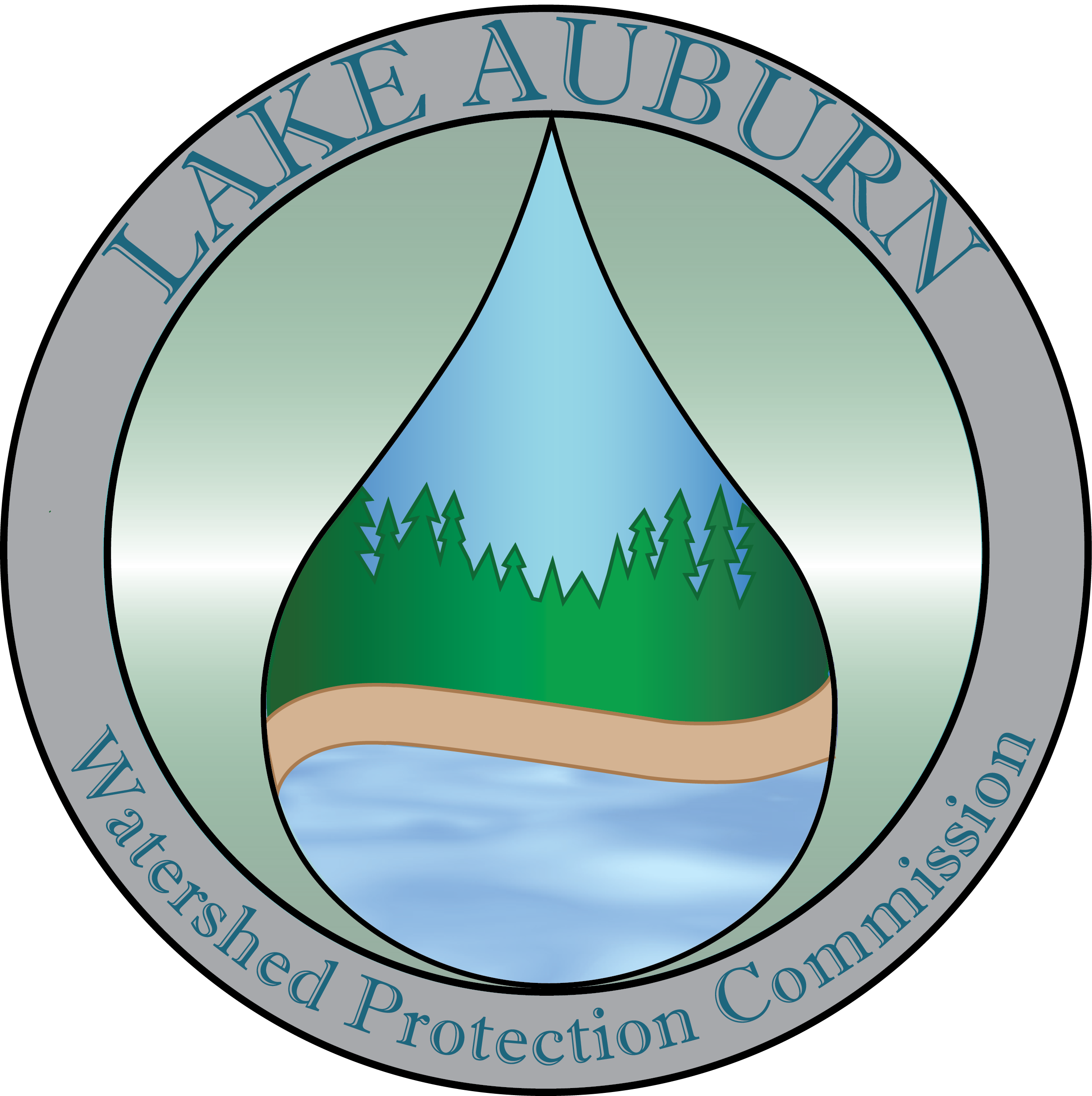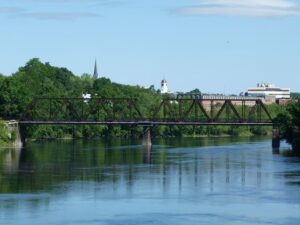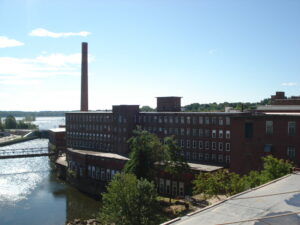Auburn River Walk
In our communities, both urban and rural, it is imperative to consider how development plays a role in conservation efforts. Without a responsible framework, development can impede conservation goals, and damage local ecosystems, such as a watershed. Fortunately, we are not alone in finding a balance between development and conservation. Frameworks, policy, design principles, and research are abundant in sustainable land-use planning. Sustainable land-use planning is defined as ensuring land management practices integrate land, water, and natural resource management to meet human needs while insuring long-term sustainability of natural resources, ecosystem services, biodiversity, and livelihood. Within the framework of sustainable land-use planning, lie several other methods which all work to help the human environment become less impactful, and create a better quality of life. Sustainable development practices enhance watersheds and forests to produce goods and environmental services that improve the welfare of people now, while preserving the environment and natural resources for future generations. Low impact development, Smart Growth, Hazard Mitigation, EcoDistricts, Local policy and ordinances, and property owners can all play a role in ensuring sustainable development goals are met.
When addressing water quality and storm water issues in a more developed area, such as urban and suburban neighborhoods, Low Impact Development (LID) can mitigate challenges these places face. Low impact development refers to a variety of practices that help the built environment mimic the natural processes found in nature. The EPA defines LID as “an approach to land development (or redevelopment) that works with nature to manage stormwater as close to its source as possible. LID employs principles such as preserving and recreating natural landscape features, minimizing effective imperviousness to create functional and appealing site drainage that treats stormwater as a resource rather than a waste product.” The Maine Department of Environmental Protection also recommends the use of the LID framework to promote sustainable development. The strategies that compose LID include; minimizing impervious surfaces, limiting areas of clearing or grading, and managing stormwater at its source. Impervious areas increase the amount of runoff as vegetation is absent and water cannot be absorbed into the ground. Reducing the amount impervious surfaces will reduce runoff. Some impervious surfaces are unavoidable, but adding separation between these areas where water can be slowed down and infiltrated can be beneficial. Rain gardens, dry wells, and level spreaders are some examples of green infrastructure that, when implemented, prevent the flow of stormwater runoff directly into a discharge point thus reducing non-point source pollution into our watershed. By limiting areas where land is cleared or graded, predevelopment conditions are preserved. This minimizes land disturbance. Areas such as wetlands, floodplains, steep slopes, streams, and lake fronts should be preserved with undisturbed buffers. To protect the preserves, identifying them in development plans, deeds, and in the field is important. Another LID strategy is to manage stormwater at the source. Reproducing the natural function of a landscape can help manage stormwater during peak-flow periods to not overwhelm the end-of-pipe treatment system and slow the stormwater down. Maine DEP recommends LID infrastructure such as vegetative buffers, filters, bioretention cells, rain gardens, Infiltration basins, roofline filters, trenches, dry wells, porous pavement such as porous asphalt, block pavers, plastic grid pavers, rain collection cisterns, and rooftop greening.
Maine Mill, Lewiston
Smart Growth is another sustainable development framework which can aid in the protection of watersheds. Typically used when making municipal or urban planning decisions, Smart Growth can help communities grow in a way that protects the natural environment, fosters economic growth, and builds stronger communities. There are ten principles of Smart Growth: Mixed land uses, compact design, diversify housing options, walkability, sense of place, open space preservation, incorporate farmland, protect natural beauty and critical environmental areas, direct development toward existing communities, transpiration variety, be fair, predictable and cost effective in decision making, encourage community and stakeholder participation. When applied, Smart Growth generally benefits the quality of life and environmental quality of cities and communities in several ways. When communities become denser, have a variety of choices for transportation, car journeys become less frequent due to shorter distances needed to travel air quality is often improved due to less air pollution from automobiles. Smart Growth principles also make communities more resilient in the face of climate change. Compact development enhanced public transportation, low-impact building practices and energy efficient buildings all help reduce the hazards of climate change. Additionally green infrastructure, and permeable surfaces mentioned in LID help prevent flooding from rain events. Often LID principles are applied to Smart Growth, so including LID in addition to Smart Growth principles water quality can be improved. Communities with old industrial sites and brownfield areas can benefit from these sites being adaptively reused and redeveloped. Brownfields are abandoned, idled, or underused industrial and commercial properties where redevelopment is complicated due to contamination. Cleaning up and redeveloping a brownfield can remove blight and environmental contamination, catalyze neighborhood revitalization, lessen development pressure on undeveloped land, and use existing infrastructure. It’s also important to conserve open space and natural areas within communities. Preserving natural lands and waterways, and encouraging growth in existing communities protects farmland, wildlife habitat, outdoor recreation, and natural water filtration that ensures clean drinking water.
Green Stormwater Infrastructure, in Minneapolis, MN
Considering potential hazards and how to mitigate them is also essential in balancing watershed protection with development. When developing land, we must consider scenarios in which a weather event such as a storm occurs and how the land may be impacted, and how development of the land may impact the area overall. FEMA defines hazard mitigation as “any cost-effective action taken to eliminate or reduce the long-term risk to life or property from natural or technological hazards.”
A new framework on the scene is EcoDistricts. Like some Smart Growth principles mentioned earlier, EcoDistricts take a more local approach and focuses on three imperatives: equity, resilience, and climate protection. Additionally, there are six other priorities within the EcoDistrict model: place, prosperity, health and wellbeing, connectivity, living infrastructure, and resource restoration. With three implementation phases: formation, roadmap, and performance. This creates an encompassing roadmap to developing cohesive, climate resilient, low-impact communities. The goal of an EcoDistrict is to integrate sustainable development and social equity.
Here in Maine, there are ordinances adopted by communities depending on their situation that must be followed regarding development and stormwater runoff management. Since all natural surface waters are at risk of the harmful effects of stormwater runoff, effective pollutant removal is necessary for all stormwater management systems. Additionally, ensuring that the stormwater runoff in treatment systems must remain at cool temperature at or below 22 degrees Celsius. Channel protection is also a required ordinance. Constructed stormwater management systems should minimize the duration and magnitude of stormwater discharge from a developed site to prevent stream bank erosion and sedimentation of downgradient stream channels. By protecting channels from erosion and controlling floods downstream infrastructure is less likely to become overwhelmed when these rain events occur. However, these events are becoming more frequent and more intense. Maine DEP says traditional flood control is unnecessary when discharging to natural bodies of water, however this does not seem to be sustainable, or responsible. More holistic approaches have been taken to control these events such as wetland, floodplain, and river restoration projects. Rivers have a natural response to these events, and humans must restore this function, and develop floodplains and areas which allow the natural ebb and flow of waters to occur responsibly. Parks and preserves are a great way to allow use of the land without building infrastructure that can be damaged, destroyed or harm the watershed. Maine DEP includes vegetative buffers and underdrained soil filter basins as the best management practices to slow the flow of stormwater and remove pollutants. They also recommend infiltration systems, and wet ponds with underdrained gravel benches. Throughout Maine different towns adopt floodplain management ordinances depending on flood hazard identification maps provided to the community by the Federal Insurance Administrator. Communities that are part of the National Flood Insurance Program (NFIP) are required to adopt an ordinance so residents can access flood insurance. In addition to ordinances adopted by municipalities enrolled in the NFIP, to protect the investment and property of residents, towns can also adopt environmentally focused ordinances to further protect the hydrology and health of the environment. Some examples of environmental-focused ordinances include steep slope ordinances, natural resource protection ordinances, conservation zoning, agriculture zoning, and tree ordinances.
Municipalities obviously have a commitment to ensuring responsible development, and should take measures steps further and adopt more progressive goals in efforts to protect natural resources and improve the quality of life for residents, but what can property owners do to help ensure that they are balancing their development with watershed protection? Property owners can build away from streams, wetlands, or other natural resources, protect open spaces, create an easement (legal agreement that limits use of land) around streams or other important natural features, and plant forest buffers on both sides of streams in efforts to mitigate environmental harm on their land and take sustainability practices in their own hands! In some place municipalities can incentivize this by offering tax credits, and other benefits for landowners who practice sustainable land-use.
There is so much that can be done to help balance watershed protection and development, and cities and communities across the country and slowly catching onto why it’s so important. From improved quality of life, economic revitalization, improved social equity, to improved environmental quality, the reasons not to adopt these principles are few. It is important to speak up in your community, get involved in the process, and make your voice heard. To establish these frameworks, we need movers and shakers to convince our community leaders to adopt these more holistic environmentally conscious initiatives and make our communities stronger, and more resilient.



